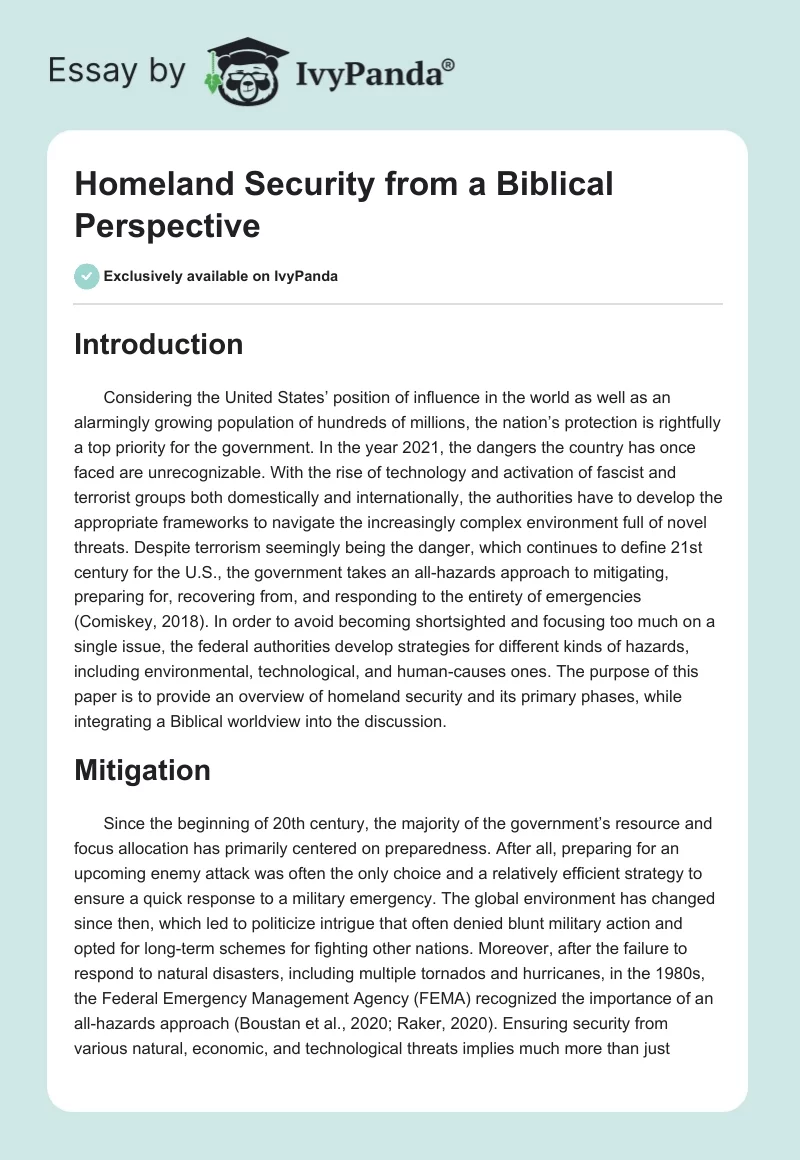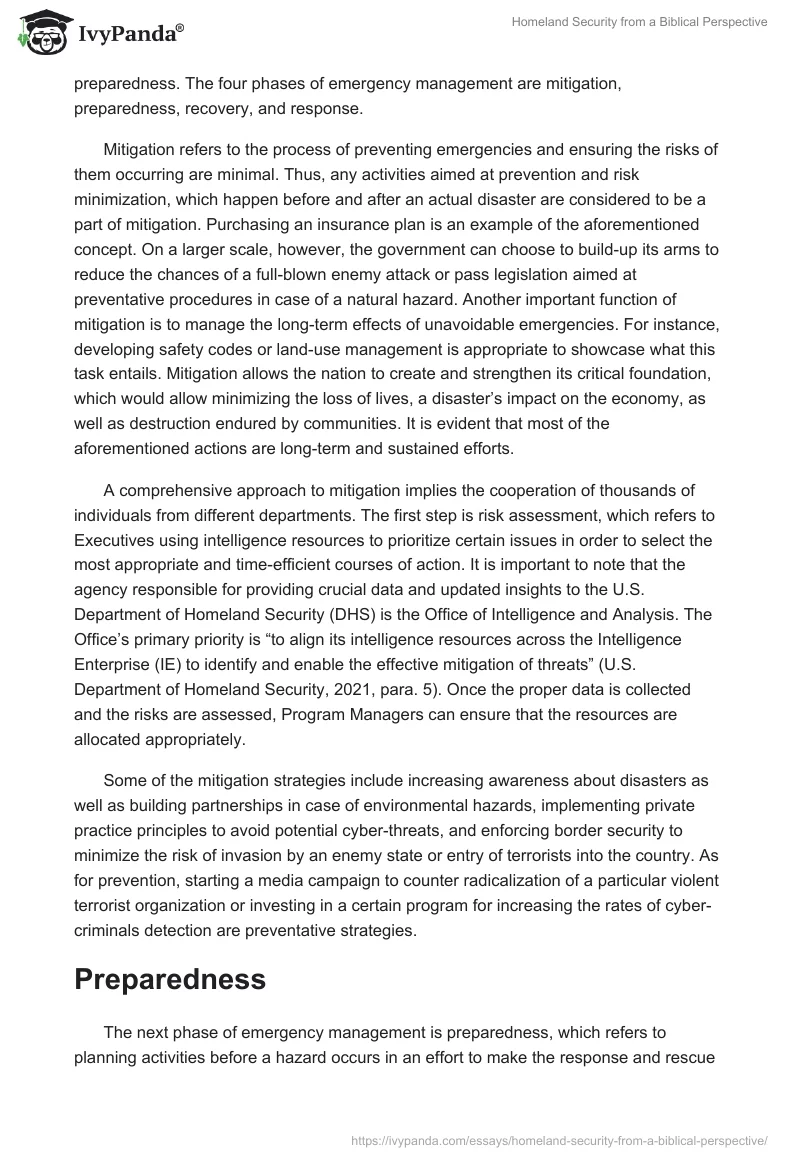Introduction
Considering the United States’ position of influence in the world as well as an alarmingly growing population of hundreds of millions, the nation’s protection is rightfully a top priority for the government. In the year 2021, the dangers the country has once faced are unrecognizable. With the rise of technology and the activation of fascist and terrorist groups both domestically and internationally, the authorities have to develop the appropriate frameworks to navigate the increasingly complex environment full of novel threats.
Despite terrorism seemingly being the danger, which continues to define 21st century for the U.S., the government takes an all-hazards approach to mitigating, preparing for, recovering from, and responding to the entirety of emergencies (Comiskey, 2018). In order to avoid becoming shortsighted and focusing too much on a single issue, the federal authorities develop strategies for different kinds of hazards, including environmental, technological, and human-caused ones. The purpose of this paper is to provide an overview of homeland security and its primary phases while integrating a Biblical worldview into the discussion.
Mitigation
Since the beginning of 20th century, the majority of the government’s resource and focus allocation has primarily centered on preparedness. After all, preparing for an upcoming enemy attack was often the only choice and a relatively efficient strategy to ensure a quick response to a military emergency. The global environment has changed since then, which led to politicize intrigue that often denied blunt military action and opted for long-term schemes for fighting other nations. Moreover, after the failure to respond to natural disasters, including multiple tornados and hurricanes, in the 1980s, the Federal Emergency Management Agency (FEMA) recognized the importance of an all-hazards approach (Boustan et al., 2020; Raker, 2020). Ensuring security from various natural, economic, and technological threats implies much more than just preparedness. The four phases of emergency management are mitigation, preparedness, recovery, and response.
Mitigation refers to the process of preventing emergencies and ensuring the risks of them occurring are minimal. Thus, any activities aimed at prevention and risk minimization, which happen before and after an actual disaster are considered to be a part of mitigation. Purchasing an insurance plan is an example of the aforementioned concept. On a larger scale, however, the government can choose to build up its arms to reduce the chances of a full-blown enemy attack or pass legislation aimed at preventative procedures in case of a natural hazard. Another important function of mitigation is to manage the long-term effects of unavoidable emergencies. For instance, developing safety codes or land-use management is appropriate to showcase what this task entails. Mitigation allows the nation to create and strengthen its critical foundation, which would allow minimizing the loss of lives, a disaster’s impact on the economy, as well as destruction endured by communities. It is evident that most of the aforementioned actions are long-term and sustained efforts.
A comprehensive approach to mitigation implies the cooperation of thousands of individuals from different departments. The first step is risk assessment, which refers to Executives using intelligence resources to prioritize certain issues in order to select the most appropriate and time-efficient courses of action. It is important to note that the agency responsible for providing crucial data and updated insights to the U.S. Department of Homeland Security (DHS) is the Office of Intelligence and Analysis. The Office’s primary priority is “to align its intelligence resources across the Intelligence Enterprise (IE) to identify and enable the effective mitigation of threats” (U.S. Department of Homeland Security, 2021, para. 5). Once the proper data is collected and the risks are assessed, Program Managers can ensure that the resources are allocated appropriately.
Some of the mitigation strategies include increasing awareness about disasters as well as building partnerships in case of environmental hazards, implementing private practice principles to avoid potential cyber-threats, and enforcing border security to minimize the risk of invasion by an enemy state or entry of terrorists into the country. As for prevention, starting a media campaign to counter radicalization of a particular violent terrorist organization or investing in a certain program for increasing the rates of cyber-criminal detection are preventative strategies.
Preparedness
The next phase of emergency management is preparedness, which refers to planning activities before a hazard occurs in an effort to make the response and rescue operations more effective. Preparedness activities are necessary because mitigation operations oftentimes do not have the ability to prevent emergencies altogether. Thus, the authorities have to ensure there are plans to reduce the damage of such disasters, to save people’s lives, as well as to enhance the frameworks aimed at responding to a hazard. Preparedness implies the improvement of the government’s operational capability to determine possible vulnerabilities and protect the nation from the enemy abusing them.
The main parts of National Homeland Security imperative for preparedness operations are National Response Framework (NRF), National Incident Management System (NIMS), as well as Incident Command System (ICS). It is crucial to note that the efforts of NRF, NIMS, and ICS are combined through unified command, which refers to the respect each one has to the established chain of command put in place to coordinate various individual activities towards common goals.
Response
Responding efficiently to an emergency involves an array of well-structure and highly-organized actions aimed at minimizing further destruction and losses during a hazard. The main functions of response activities are to help with casualties and minimize the risk of secondary damage. Another crucial aspect of this phase is speeding up recovery through systematic injuries and damage assessment as well as providing medical assistance. The main differences between response and recovery are that response takes place during an emergency, while recovery happens after, as well as that response is aimed at short-term outcomes, while recovery ensures long-term results. The primary aspects of response operations include “(1) developing a single set of objectives, (2) using a collective, strategic approach, (3) improving information flow and coordination” (U.S. Department of Homeland Security, 2016, p. 4). It is evident that response operations are aimed at ensuring the combined efforts of various agencies and experts are centered on a single set of objectives and one plan, which everyone should follow.
Recovery
Recovery activities imply the process of returning to normal, which takes place after a disaster. On the one hand, the authorities implement short-term solutions to ensure the minimum of operating capabilities of the systems affected by an emergency. On the other hand, recovery involves long-term projects to improve the situation through community planning or legislation. It is important to note that recovery may be concurrent with the response efforts. Moreover, the core recovery activities might have similar functions as response capabilities. Linnenluecke and McKnight (2017) argue that the primary factor in determining recovery from a natural disaster is community resilience. The authorities can ensure that more communities are resilient through active collaboration with the private sector, according to Linnenluecke and McKnight (2016). Thus, as long as businesses and corporations remain resilient, the individual damage in local communities can be minimized. Another important factor in recovery efforts is continuity of organizational planning. Program Managers and Executives must develop policy and internal regulations critical for sudden alterations, which would require immediate resource allocation, employee deployment and relocation, or fast notification of different departments involved.
The Christian Worldview
There is a common misconception that religion is divided from state in all aspects. Firstly, people tend to forget the history of the United States and the incorporation of core Christian values into all of the defining documents of the American nation, including the U.S. Constitution and the Declaration of Independence. Secondly, faith guides individuals in everything they do, including the country’s politicians involved in the crucial legislative, executive, and judiciary processes. The Bible can tell a lot about homeland security. Psalm 127 notes that “Unless the Lord watches over the city, the watchmen stand hard in vain.”
While American citizens should entrust their government with protecting their rights, faith should guide them in advocating for certain homeland security action or its lack thereof. The decisions made by the government should reflect Christian beliefs. Noah’s story is an example of choosing to be guided by Christian values, collecting intelligence from God, mitigating risks by ensuring every species could procreate, preparing for the flood, sailing away, and then continuing the existence of the human race and the majority of the planet’s animals.
Conclusion
In conclusion, the meaning homeland security as shifted over the recent decades, partially due to the previous administration’s failures as well as the emergence of novel threats. In the context of an all-hazards approach, homeland security involves four primary stages, each one being integral to effective emergency management. The Christian worldview emphasizes that any mitigation, preparedness, recovery, or response efforts have to follow Biblical values.
References
Boustan, L. P., Kahn, M. E., Rhode, P. W., & Yanguas, M. L. (2020). The effect of natural disasters on economic activity in US Counties: A century of data. Journal of Urban Economics, 103257.
Comiskey, J. (2018) Theory for homeland. Security Journal of Homeland Security Education, 17, 29–45. Web.
Linnenluecke, M. K., & McKnight, B. (2016). How firm responses to natural disasters strengthen community resilience. Organization & Environment, 29(3), 290–307.
Linnenluecke, M. K., & McKnight, B. (2017). Community resilience to natural disasters: the role of disaster entrepreneurship. Journal of Enterprising Communities: People and Places in the Global Economy, 11(1), 166–185.
Raker, E. J. (2020). Natural hazards, disasters, and demographic change: The case of severe tornadoes in the United States, 1980–2010. Demography, 57, 653–674.
U.S. Department of Homeland Security. (2021). Office of Intelligence and Analysis. DHS. Web.
U.S. Department of Homeland Security. (2016). National Response Framework. Ready. Web.


